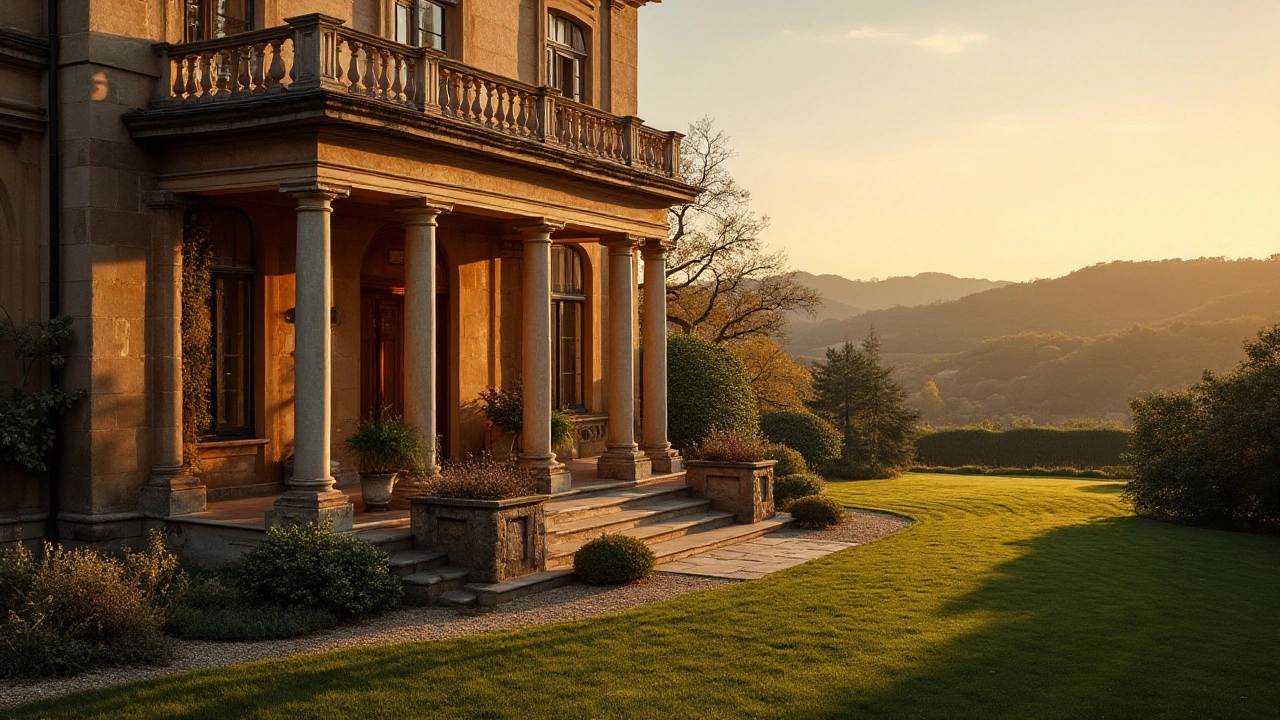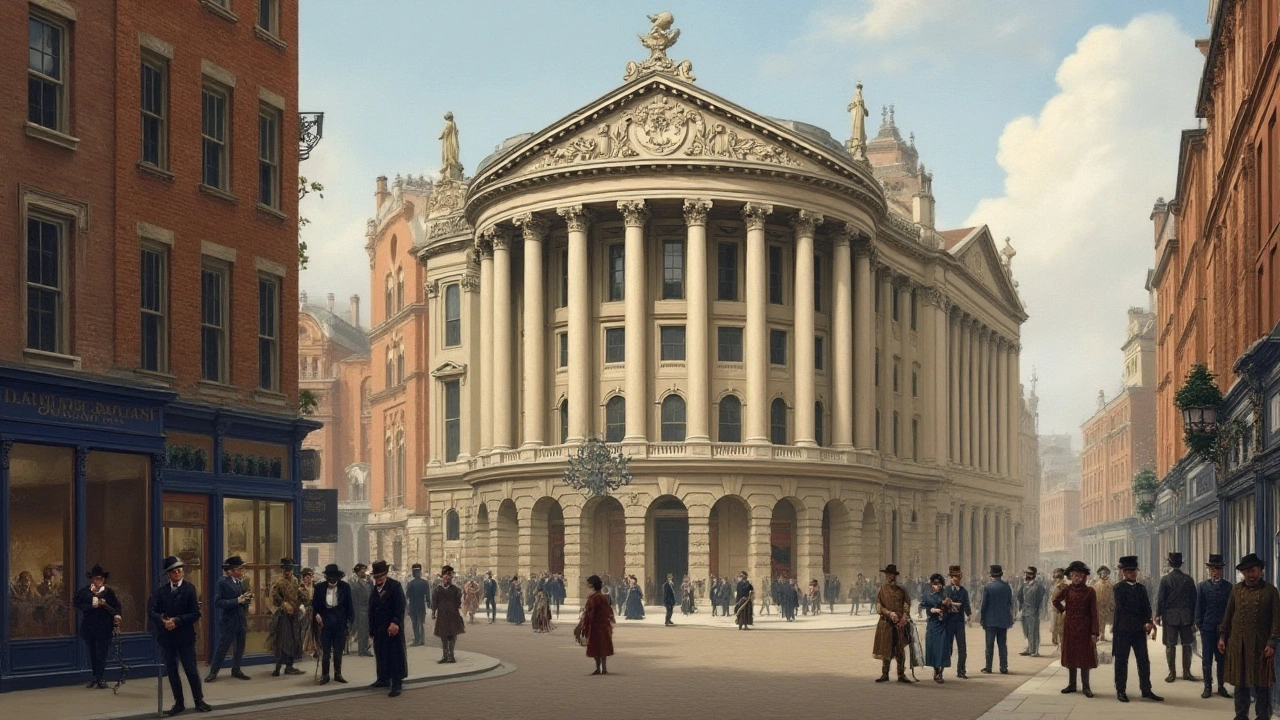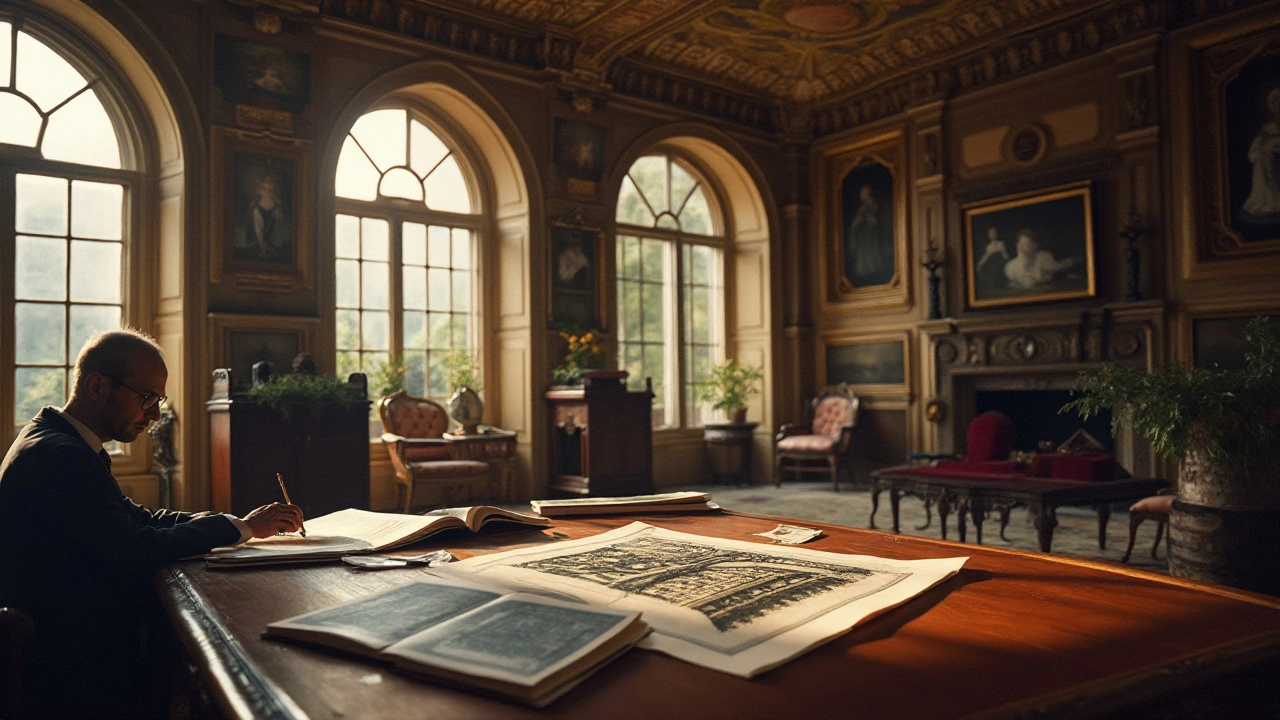Exploring Italianate Architecture: History and Cultural Significance
 Jan, 27 2025
Jan, 27 2025
Step into the world of Italianate architecture, an exquisite style that takes cues from classical Italian villas with a touch of 19th-century flair. Originally bursting onto the scene during a time when people were enamored with romantic visions of Italy, this style quickly captured imaginations far and wide.
Known for its gracefully sloping roofs, ornate details, and arches that mimic the Renaissance spirit, Italianate architecture doesn't just build structures; it crafts stories of elegance and timeless beauty. This approach soon became a beloved choice for domestic homes and grand public buildings alike, leaving a mark across continents.
As you explore this fascinating topic, you'll find there's more to Italianate architecture than meets the eye. It's a tale of cultural adaptation, an ode to a certain opulence, and at its heart, a celebration of artistic flair embodied in bricks, mortar, and history.
- Origins and Historical Context
- Key Characteristics of Italianate Style
- Prominent Examples of Italianate Architecture
- Cultural Influence and Adaptation
- Italianate Architecture in Modern Times
- Tips for Identifying Italianate Features
Origins and Historical Context
The allure of Italianate architecture owes much to its roots in the picturesque landscapes of Italy and the revival of Romantic ideals during the early 19th century. This style erupted during a time when architects and builders were passionately enamored with the beauty and harmony of Italian Renaissance villas. Taking inspiration from places like Tuscany and the Lombardy region, they sought to capture the essence of these idyllic structures, characterized by their nuanced austerity and serene elegance. It was an era when the appeal for ancient Roman culture mingled with a thirst for modern innovation, creating a fertile ground for the conception of the Italianate style.
In England, this style was popularized by architects such as John Nash and Sir Charles Barry, who took the liberty of blending classical elements with contemporary necessities. It first gained traction with countryside homes, providing an escape to a mythic Italy without ever boarding a ship. This transformation was not isolated to England, soon spilling over into the United States through the hands of figures like Andrew Jackson Downing. Downing's publications spread the architectural gospel of Italianate homes, boasting avant-garde elements like low-pitched or flat roofs and towering cupolas, thus influencing American domestic architecture extensively. It's interesting to note how this blend of influences catered to more than aesthetics; it was about middle-class aspirations and an expression of cultural sophistication.
"The Italian manner of building, with its pleasing irregularities and picturesque outlines, is perhaps better adapted than any other style to harmonize with the surrounding landscape, and combine beauty with convenience." - Andrew Jackson Downing
The style's proliferation was not solely a product of artistic pursuit. Society was undergoing seismic shifts with industrialization, urbanization, and expanding railway networks, urging architecture to mold itself to fit new dynamics. Italianate designs fit perfectly into these emerging towns and cities, their adaptability allowing them to suit both large urban environments and tranquil rural retreats. Interestingly, while the style naturally embodied traditional Italian themes, it was often mixed with local motifs, reflecting a world in flux. As the style traversed continents, it paved the way for adaptations that included vibrant decorative brackets and cornices, which became staples in varied environments, from bustling New York streets to pastoral Australian countrysides.
Interestingly, the flexibility of Italianate architecture catered to the diverse climates and environments found globally. In parts of Australia, for instance, distinct elements were integrated to adapt to local conditions, showcasing a remarkable versatility and resilience. This newfound global diffusion saw the emergence of unique stylistic deviations that were directly influenced by geographic and cultural settings, a testament to the adaptable nature of Italianate architecture.
Key Characteristics of Italianate Style
Italianate architecture is a historical architecture style that distinctly stands out, weaving an intricate tapestry of elegance and classical formality. Emerging in the mid-19th century, it was inspired by 16th-century rural villas of Italy, notable for their emphasis on grace and decorative flair. One can't miss the distinguished low-pitched or flat roofs, often accompanied by overhanging eaves braced by corbels. These eaves form a visually elongated profile that echoes the natural sweeping vistas of the Italian countryside. What truly marks this style is the use of square towers or cupolas, frequently poised dramatically above the rest of the structure, offering an air of grandeur that catches the eye.
Step inside, and the internal spaces often emphasize verticality, with high and expansive rooms that seem to invite light and create an unnoticed flow. Arched windows, sometimes doubling or tripling together in pairs, are an incredibly common feature. These are typically adorned with elaborate crown molds or pronounced hood moldings that add to the dramatic effect. You may find that the doorways follow suit, framed by bold pilasters or columns, which echo a nod to classical motifs.
"The Italianate style, often showcasing a blend of both Greek Revival and Renaissance traits, captures an elegance that architects in the Victorian era admired greatly," asserts Sir John Smith, a sage of architectural history.
The decorative brackets beneath the eaves and the detailed window cornices reflect the ornamental detailing that is synonymous with Italianate architecture. This style not only caters to aesthetics but also provides a storytelling narrative, where each feature relays a nod toward Renaissance inspirations. Walking around quintessential Italianate homes, circular or rectangular porches frequently wrap their facades, inviting moments of leisure akin to the Italian tradition of ‘fare la dolce vita.’
Architectural journals from the era often alluded to how Italianate buildings presented a sense of prosperity and comfort. Exterior facades were traditionally rendered in stucco or smooth stone, often painted in earthy tones, blending harmoniously with the landscape. The subtleties of polygonal bay windows granted the homes a sense of rhythm, influencing the way shadows and light danced across the interior. Consider how visually striking these edifices might have seemed against their more austere Neoclassical neighbors of the period. This juxtaposition played a crucial role in popularizing the style among affluent homeowners across continents.
Italianate architecture not only served as a template for domestic homes but also influenced a spectrum of public edifices—courthouses, libraries, and even railway stations adopted its principles. You'll often discover cast-iron or wooden porches set against the facade, brimming with a lacy look, reminiscent of the Mediterranean gewgaws that once inspired its creators. A remarkable aspect is its versatility, the ability to accommodate various Vincian and Palladian traits while retaining its signature charm. Such adaptability is perhaps why the style has endured, evolving with time while maintaining its historic essence.

Prominent Examples of Italianate Architecture
Italianate architecture enjoys pride of place with many notable examples scattered across continents. One such gem is Osborne House on the Isle of Wight in England, a residence of Queen Victoria and Prince Albert. Designed by architect Thomas Cubitt in conjunction with Prince Albert himself, Osborne House sits as a magnificent testament to the romantic allure of the Italianate style. Its grand terraces and elaborate roofs exude elegance, beautifully capturing the essence of classical Italian villas. The house's towering belvedere, an observation tower common in Italianate designs, offers sweeping views that stretch far beyond its strikingly manicured gardens.
Across the Atlantic, the United States boasts its fair share of Italianate architecture. San Francisco’s “Painted Ladies”, a row of Victorian houses, are celebrated for their ornamental accents and quintessential Italianate features. These buildings, constructed during the latter half of the 19th century, symbolize a time in American history when architectural tastes leaned heavily on European influences. Their charm lies not only in their resilience through time but also in how they stand etched against the city’s modern, dynamic skyline.
Further east, the Pabst Mansion in Milwaukee stands as another dazzling specimen. Built for Captain Frederick Pabst, the mansion dazzles with its intricate designs, decorative windows, and majestic portico. The design choice not only reflected opulence but also echoed the cultural tastes that were prevalent among the wealthy elite of the time. It’s often said that a style speaks volumes about those who reside within, and this holds true for Italianate architecture as seen in such historic homes.
"The genius of Italianate architecture is not merely in its ornate facades, but in its power to evoke the warmth and nostalgia of the Mediterranean," architectural historian James Stevens Curl remarks.
In Australia, Melbourne’s boom period left behind an Italianate treasure in the form of Victorian-era terraces. Houses splashed with vibrant colors and adorned with decorative parapets reflect a period of growth and aspiration. Their dual-floor balconies support intricate cast iron lacework, a romantic nod to Italian inspirations seen globally. Even local adaptations have flourished, artfully blending influences to create something distinctively ‘Aussie’.
The beauty of these Italianate architecture examples often lies in their details. From bracketed cornices to rounded windows and double columns, they blend function with aesthetics, showing us how adaptable this style truly is. Often complemented by lush gardens and strategically placed fountains, these structures tell a story of elegance that transcends borders. Their enduring popularity is a tribute to their timeless design, capturing imaginations and lingering as jewels of architectural heritage.
Cultural Influence and Adaptation
Italianate architecture isn't just a style; it is a testament to the cultural exchanges of the 19th century. As architectural historians often point out, this style emerged during a time when there was a growing appreciation for Renaissance art and culture. People were captivated by the romanticism of Italy, which was seen as a cradle of art and humanism. The adaptability of this architectural style is one of its defining features. It managed to weave its way into various cultures, leaving an imprint on both European and North American landscapes.
The appeal of the Italianate architecture transcended the aesthetic, embodying a certain cultural aspiration. Many architects and builders saw in it a reflection of sophistication and classical elegance. In the United States, for example, you could easily find city halls, train stations, and residential buildings adorned with Italianate elements by the mid-19th century. This was a period when America was developing its own cultural identity, looking across the Atlantic for inspiration, and what better place to look than the historic lands of Italy? This style represented a respect for tradition, an appreciation of beauty, and an attraction to the elaborate details which signified importance and prestige.
"What is Italianate architecture but an embrace of the past, intertwined with hope for a cultured future? From the banks of the Thames to the shores of the Hudson, its presence is a tribute to history's lasting impression." – Anonymous architectural historian.
The adaptability of the Italianate design allowed it to evolve over time, absorbing local cultural influences. In Australia, particularly in Melbourne where the gold rush era led to a boom in building, Italianate structures became synonymous with prosperity. Walk along the avenues or visit the Victorian towns, and you'll see facades that reminisce Italy's old-world charm, yet each carrying subtle local flavors. It’s quite intriguing how the verandas stretched wider and more decorative in these antipodean settings, adapting to the warmer climate and outdoor lifestyle of Australians.
Interestingly, this style wasn't just about luxury; it was highly accessible due to its flexibility in design and ornamentation. The Italianate architecture varied significantly in complexity and cost, making it a popular choice for everything from opulent mansions to modest houses. This broadened its cultural reach, enabling many from different walks of life to partake in this architectural splendor. As cities began to expand and develop, this inclusivity allowed the Italianate style to become entrenched in the very fabric of new urban landscapes, signifying a democratization of architectural beauty.
Today, enthusiasts of historical architecture continue to find charm in the remnants of Italianate structures. These buildings invite us to not just admire, but to imagine the cultural exchanges they inspired and witnessed. Whether as preserved landmarks or restored homes, their enduring presence speaks volumes of a bygone era, weaving a tapestry of history and innovation that still captures the imagination of those seeking beauty in design and history alike. In modern architecture, Italianate influences serve as a reminder of our shared love affair with Italy's rich architectural legacy, a truth that remains relevant even now.

Italianate Architecture in Modern Times
Despite its origins in the 19th century, Italianate architecture continues to capture the imagination of designers and homeowners today. One reason for its enduring appeal is its ability to convey elegance and grandeur, bridging the old-world charm with contemporary sensibilities. This style, which once adorned the streets of Europe and North America, has adapted to modern needs while retaining its distinctive characteristics, such as decorative brackets under wide eaves and tall, narrow windows with rounded tops.
In today’s cities, remnants of Italianate design can often be found in renovated townhouses and historical society projects, where preserving architectural heritage is of paramount importance. Many architects appreciate how this style's ornate details can be merged with minimalist aesthetics to create a striking contrast. Such design endeavors offer a unique blend of historical and modern tastes, providing a testament to Italianate architecture's versatility. Interestingly, a recent survey showed a resurgence of interest in this classical style among mid-century architecture enthusiasts, with 37% of respondents expressing a desire for integrating historical elements in new construction.
The cultural significance of Italianate design cannot be understated. It's not only about replicating an old style; it's about celebrating and reinterpreting it for new generations. This adaptation often involves sustainable materials and energy-efficient practices, which help extend the lifespan of these beloved structures. In areas like Melbourne, the preservation of Italianate features aligns well with community values focusing on sustainability and heritage resilience.
"Preserving Italianate architecture allows us to maintain a physical connection to historical narratives, providing context in a rapidly modernizing world," said Jane Goode, a notable architecture historian.
For developers and renovators, incorporating Italianate architecture involves a keen attention to detail and an understanding of its cultural roots. These projects remind us that architecture is as much about the past as it is about the future. As urban landscapes evolve, there is an increasing appreciation for styles that tell a story, adding depth and character to the communities that uphold them. Ultimately, Italianate design serves as a canvas, allowing for a marriage of history and modern innovation that resonates with a sense of timeless charm.
Whether seen in high ceilings of converted lofts or exquisite facades of newly built homes, the spirit of Italianate architecture remains visible. The style's influence extends into furniture design, interior decorating, and landscaping, demonstrating its profound impact well beyond brick and mortar. It’s a style that continues to inspire creative solutions and aesthetic joy, proving that some architectural stories are eternally relevant.
Tips for Identifying Italianate Features
Italianate architecture is a treasure trove for aesthetes and history lovers alike. One of its signature traits is the wide, overhanging eaves supported by decorative brackets, a feature that echoes the rustic charm of the Italian countryside. When you're gazing at a building and you notice these deep eaves casting dramatic shadows, it's a telltale sign you're looking at a structure wrapped in the elegance of Italianate design. These eaves aren't just about aesthetics; they also reflect ingenious construction, providing shade and helping in temperature control—a nod to the thoughtful craftsmanship of the era.
Majestic Windows and Doors
Windows and doorways in an Italianate building are noteworthy for their grandeur. Look for tall, narrow windows often rounded or arched at the top—a signature look taken from the Renaissance period, intended to mirror the opulence of Italian palazzos. These windows frequently feature embellished crowns or robust moldings that add depth and detail to the facade. Doors, too, mirror this stately aesthetic, often highlighted by ornate columns or pilasters, giving the entryway a regal presence that's hard to ignore. When walking past an Italianate structure, these windows and doors are sure to catch the eye and invite admiration.
Balanced Symmetry and Vertical Proportions
Another element that shines through in Italianate architecture is the emphasis on symmetry and vertically stretched proportions, which lend a sense of majestic elevation to buildings. This style often features a central square tower or rectangular bay that projects above the rest, offering a focal point that underscores its vertical ambitions. The tales of grandeur told through these towering elements are reminiscent of Italian villas, where height and symmetry symbolize strength and stability. Lewis Mumford, a renowned historian, noted,
"The Italianate villa merges harmoniously with the landscape, yet proclaims the spirit of human ascendancy in its vertical lines."Such balance and proportion underscore the grandiose ambitions Italianate architects aspired to convey.
Distinctive Rooflines and Ornamentation
The rooflines in Italianate buildings are a canvas of stylistic experimentation. Featuring low-pitched or flat roofs, they often boast cupolas or belvederes, which serve not only as ornamental pieces but also as lookout points—reminiscent of their Italian origins, where surveying vast landscapes was both practical and picturesque. The ornamentation doesn’t end there. Scroll brackets, cornices adorned richly with decorative motifs, and intricate friezes often bring an additional layer of beauty, elevating what might otherwise be a simple brick facade into a piece of art. Such embellishments are a hallmark of the Italianate style, showcasing an unapologetic flair for ornate craftsmanship that captures one's imagination.
Materials and Color
Typically, Italianate buildings are constructed from brick or wood, later painted in earth tones echoing the Tuscan and Mediterranean landscapes. Creams, ochres, and muted greens are favored, inviting a warm, inviting feel to these magnificent structures. The color palette not only complements the ornate details but also ties the building aesthetically to its natural setting, a perhaps less tangible but no less important facet of Italianate architecture. This connection to nature through color and material choice reflects a cultural embrace of harmony between the built environment and the world it inhabits.